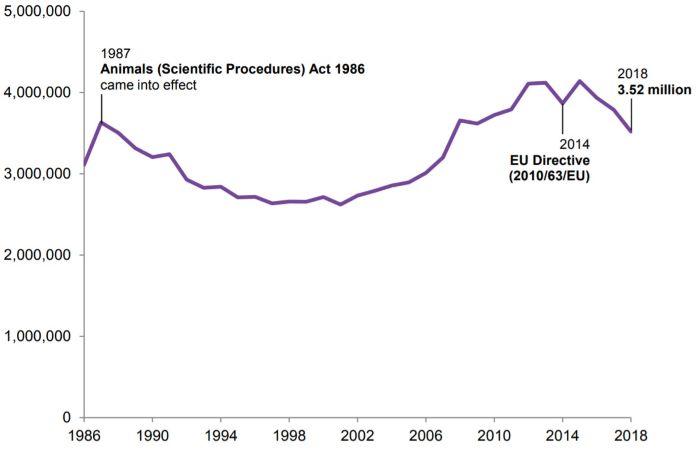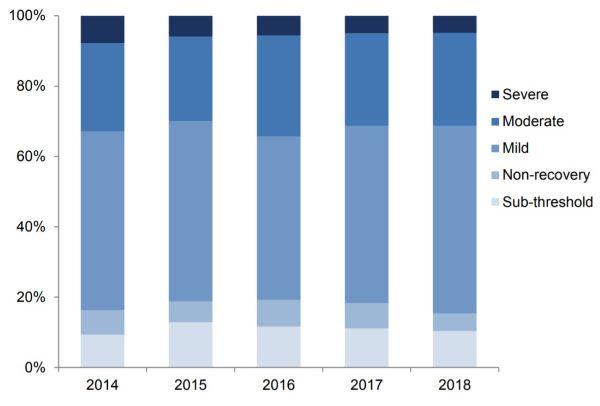Animal research statistics in 2018
Last week, the Home Office published the 2018 statistics of scientific procedures on living animals in Great Britain.
The statistics show that last year, 3.52 million procedures involving living animals were carried out in Great Britain. This is a decrease of 7% from 2017, and the lowest number of procedures since 2007. Nearly half of these procedures were carried out by ten organisations, including the Medical Research Council, the Francis Crick Institute and the University of Oxford.
It is important to note that the number of procedures referred to in the statistics does not necessarily correspond with the number of animals that have been used in procedures that year. This is because some animals may be used in more than one procedure, which can include taking a blood sample or MRI scan. As each procedure involving the same animal is being counted separately, the number of procedures is usually slightly higher than the number of animals used.
The Home Office statistics are published every year and cover England, Scotland and Wales. In Northern Ireland, the Department of Health separately collects and publishes information on regulated procedures under devolved arrangements.
Key takeaways
- Half of all procedures were experimental procedures (1.80 million), meaning procedures involving the use of animals in scientific studies for purposes of basic research, the development of treatments and the safety testing of medicines.
- The other half were for the creation and breeding of genetically altered animals (1.72 million). These procedures refer to the breeding of animals whose genes have been altered. The animals created in this way are not themselves used for experimental procedures, but their offspring are.
- The majority (93%) of procedures used mice, fish and rats. These species have been the most used for the past decade. Cats, dogs and primates accounted for less than 0.2% of all procedures.
- Over half (56%) of experimental procedures were for the purpose of basic research, most commonly focusing on the immune system, the nervous system and cancer.
Why animals are used in research
Animal research has a vital role in the research and development of new medicines and is strictly regulated in the UK. The use of animals in the development of medicines is also a legal requirement to help determine the safety of medicines before human trials.
Animals are used in conjunction with other scientific techniques, such as organ-on-a-chip and computational models, to help researchers advance our understanding of biology to treat disease. The UK scientific community is committed to the principles of the 3Rs to improve the standards and quality of science involving animal research, these are:
- Replacement – methods which avoid or replace the use of animals
- Reduction – methods which minimise the number of animals used per experiment
- Refinement – methods which minimise animal suffering and improve welfare
2018 compared to previous years

Figure 1: Total scientific procedures in Great Britain, 1986 to 2018
As shown in Figure 1, the total number of procedures performed each year decreased from 1987 until 2001. This decrease was mainly due to a reduction in the use of rodents, rabbits and birds (although there was an increase in procedures involving fish).
After 2001, procedures increased, reaching a peak of 4.14 million in 2015, but has decreased since to 3.52 million in 2018, which is the lowest number of procedures carried out in a single year since 2007.
The number of animal research procedures is determined by several factors, including the focus of scientific and medical endeavours, the economic climate and global trends in new technologies or fields of research.
![Animal figure 2 edit].jpg](https://www.bioindustry.org/static/derivatives/650x388_highestperformance_/d3d0f7d7-8232-42de-adddea061a8fa0b7.jpg)
Figure 2: Total scientific procedures by type, 2009 to 2018
As shown in figure 2, the total number of procedures was rising before 2013, largely due to the increase in procedures for the creation and breeding of genetically altered animals. This increase is mainly attributed to the availability of new technology and research areas, according to the Home Office report. However, the number of procedures for the creation and breeding of genetically altered animals has been decreasing in recent years, with a 10% reduction compared to 2017.
The severity (pain, distress or suffering) experienced by animals in procedures has been recorded since 2014, when a new EU Directive came into effect. In 2018, 90% of all experimental procedures were assessed as sub-threshold, mild or moderate in severity. The number of procedures categorised as Severe and Moderate remained the same compared to 2017.

Figure 3: Experimental procedures by severity, 2014 to 2018
Why these statistics are important
Animal research is an understandably emotive subject, so it is important that the scientific community and the Government are transparent and open about it. The BIA is a signatory of the Concordat on Openness on the Use of Animals in Research. This agreement is supported by a range of organisations – including universities, companies, research funders and umbrella organisations – to commit to being open about the use of animals in research in the UK. You can also read the BIA’s position on animal research on our website.
The UK ranks among the highest in the world for the welfare of animals used in research, and these annual animal research statistics are an important part of ensuring our high welfare standards continue.
.png)
.png)